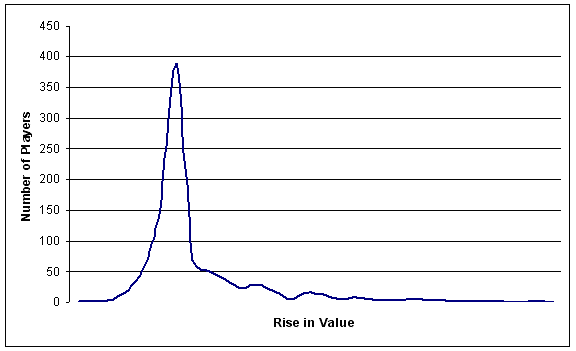Is the current collective bargaining agreement solely responsible for the crash in free agent values? We mentioned this in passing during a recent Roundtable, but it’s worth a more in-depth look.
As Doug Pappas has noted, revenue sharing reduces the marginal value of players. What that means is that if you’re the Red Sox, and you worked out that a win was worth $1 million to you in additional raw revenue from merchandise, next year’s radio deal, and so forth, if you share your revenue with the other 29 teams, that amount is reduced.
So for instance, say you share half your revenue. You now give away half that money to the other clubs and receive a partial share back from that. Or:
$500,000 + ($500,000 * 1/30)= $516,666.67 value per win
So take the case of one Joe Player, who you figure is worth an amazing 10 wins over a guy you could get for the league minimum. Your offer in a world without revenue-sharing might be $10 million. With 50% revenue sharing, it’s $5,166,667.
Of course, if Joe Player can get you into the playoffs, or he’s got a winning smile and the fans will turn out for him, you might be willing to pay more.
The next issue becomes scarcity. If you look at any player metric, you get a distribution that looks like this:

In this case, I used VORP for position players. At the far, far left are Brandon Phillips and Jermaine Dye; the hump is around replacement level.
While you can find hundreds of players who performed around replacement level, you can only find one Joe Player at +100. Sp Joe Player is not just impossibly valuable, he’s unique and the most scarce commodity you can buy, and commands a premium.
Plus there’s the problem of lineups. If you form your lineup out of nine Joe Replacements, you’ll find them easily and can pay them nothing–about $350,000 a head, for a total payroll that’ll run you under $10 million for the season. If you stop there, you field the worst team possible, you’ll make $30 million dollars, and maybe more, just from shared national revenue, like television (including the Japanese broadcast deals clubs like the Yankees and Mariners are responsible for bringing in) and revenue sharing. There’s a huge incentive for teams to languish.
Making small, marginal upgrades comes pretty easily. But there’s increasing resistance as you move up, because you compete with every other team trying to make the same modest upgrades. Joe Player now becomes far more valuable because not only can he get you 10 wins, you would otherwise have to upgrade 10 different positions by one win apiece, making life a little harder each time.
Joe Player’s constant scarcity doesn’t mean that what a team can offer stays the same though. Revenue sharing always chops the market for the players you want if you’re building a winning team.
Take the Red Sox as a hypothetical example again. If they win 110 games and the World Series, they figure they’ll take in $300 million in money over what they’d make if they sat around and twiddled their thumbs. So if John Henry’s feeling generous, he could spend $200 million in payroll at a decent chance to win it all. A good shot at the championship requires the team to pay dearly for the most scarce and valuable resources, and one upgrade isn’t going to do it.
Given that they’re only going to make $155 million if they’re sharing half that additional revenue, though, they’ll sit back and work the numbers again. If the pot’s spotting them two-in-three odds again, the team might be willing to spend only an additional $100 million now. Where they might have tossed $20 million at an outfielder, $20 million at a shortstop, and down the line, they’re likely going to make a much different set of choices now. Perhaps they pick only one superstar, then take the best remaining player who’ll take $15 million, and so on. No matter how they decide to scale back, the money they and the other spenders have to get where they want to be is chopped in half.
The effects of revenue sharing might go further than any other reason in explaining this weird off-season. It severely changes what the spenders will pay, with every team now able to afford a few signings (Throw $6 million in a two-year deal to a random left-fielder? Sure, why not). But I have to admit that no single explanation exists yet for what in the world’s been going on this off-season, and we’re probably not going to be able to put together a good explanation until Opening Day, or later.
Thank you for reading
This is a free article. If you enjoyed it, consider subscribing to Baseball Prospectus. Subscriptions support ongoing public baseball research and analysis in an increasingly proprietary environment.
Subscribe now